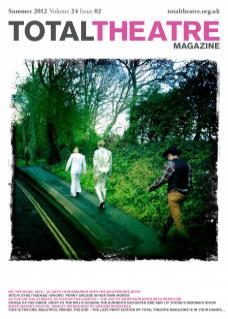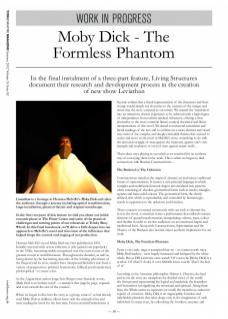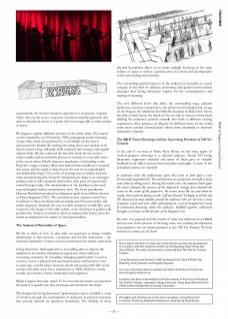Leviathan is a homage to Herman Melville’s Moby Dick and takes the audience through a journey including spatial transformation, large installation, physical theatre and original soundscape.
In the first two parts of this feature we told you about our initial research phase at The Pinter Centre and some of the practical challenges and turning points of our rehearsals at Trinity Buoy Wharf. In this final instalment, we’ll delve a little deeper into our approach to Melville’s novel and into some of the influences that helped shape the content and staging of our production.
Herman Melville’s novel Moby Dick was first published in 1851. Initially received with severe criticism, it only gained vast popularity in the 1920s, becoming widely recognised over the years as one of the greatest novels in world literature. Throughout the decades, as well as being drawn by the fascinating accounts of the whaling adventures of the Pequod and its crew, readers have interpreted Melville’s tale from a variety of perspectives: political, homoerotic, biblical, psychoanalytical, philosophical – to name a few.
As the Argentinian author Jorge Luis Borges once famously wrote, Moby Dick is an ‘infinite novel’ – a narrative that ‘page by page, expands and even exceeds the size of the cosmos’.
When we began to dive into the story as a group, some of us had already read Moby Dick as children, others knew only the main plot line and were reading the book for the first time. From our initial brainstorms it became evident that a literal representation of the characters and their voyage would simply not do justice to the vastness of the images and issues that the story conjured in our minds. We wanted the ‘translation’ into an immersive theatre experience to be achieved with a high degree of independence from realistic nautical references, offering a firm alternative to the more common literal, comical, theatrical and filmic interpretations of this novel. We aimed to transcend naturalistic and literal readings of the text and to embrace in a more abstract and visual way some of the complex and deeply existential themes that seemed to excite and move us the most in Melville’s story: something to do with the universal struggle of man against the irrational, against one’s own strength and weakness, or even of man against nature itself…
These ideas were playing in our mind as we searched for an aesthetic way of conveying them in the work. This is when we began to find connections with Russian Constructivism…
The Rational vs The Unknown
Constructivism stands at the origin of abstract art and rejects traditional forms of representation. It creates a new pictorial language in which complex and multifaceted natural shapes are translated into patterns often consisting of absolute geometrical forms such as circles, triangles, squares and basic solid colours. The geometrical form, the clearly defined, that which is reproducible and controlled by human logic, stands in opposition to the unknown and formless.
These concerns resonated enormously with our wish to abstract the text in the novel, to translate it into a performance that utilised concrete elements of spatial transformation, manipulating volume, mass, colour and rhythm in order to involve audiences on an emotional, haptic and intellectual level. Along with Constructivism, Suprematism and the Theatre of the Bauhaus also became major aesthetic inspirations for our work.
Moby Dick, The Formless Phantom
From a very early stage it transpired that we – in common with most Moby Dick readers – were hugely fascinated and intrigued by the white whale. But as DH Lawrence once stated: ‘Of course he [Moby Dick] is a symbol. Of what? I doubt if even Melville knew exactly. That’s the best of it.’
According to the American philosopher Hubert L. Dreyfus, the land and sea in the story are metaphors for divided views of the world: the firm ground representing the logical and analytical; the boundless and bottomless sea signifying the emotional and spiritual. Along these lines, the Whale seems to represent (or recall) the mysterious, unknown aspects of existence. Moby Dick is an ungraspable, formless and indefinably phantom that takes shape only in the imagination of each individual. In many ways, by embodying the formless, uncanny and supernatural, the creature stands in opposition to its pursuer, ‘Captain Ahab’, who can be seen to represent a modern scientific approach that aims to disenchant nature to a point that it no longer fills us with wonder or terror.
We began to explore different versions of the white whale. We created a scene inspired by an El Lissitzky 1920s propaganda poster featuring a huge white circle being pierced by a red triangle (at the time it represented the Bolsheviks striking the ruling class) and another work based around a huge inflatable cloth sculpture that emerges and engulfs captain Ahab. We also explored the fact that whale fat was used to create candles and reversed this process to connect it to an early scene in the novel, where Elijah’s character prophesies a bad ending to the Pequod’s voyage: a bucket filled with melted white candlewax is poured into water, and the rapid cooling freezes the wax in an unpredictable and indefinable shape. The action of pouring wax or molten lead into water and predicting the future by interpreting its shape is an old pagan tradition that is still commonly practiced in wide parts of eastern and central Europe today. The interpretation of the formless is also used in psychological studies and projective tests. The Swiss psychiatrist Herman Rorschach produced ten diagrams made from inkblots known as Psychodiagrams (1921). The associations that a patient would have in relation to these would provide an insight into their personality and enable diagnosis. Similarly, the way in which characters in Melville’s story respond to the image of the white whale, or the doubloon (a golden coin promised by Ahab as a reward to whoever captured the beast), gives the reader an insight into the nature of their personalities.
The Animated Materiality of Space
We like to think of how we play with our structures as being a similar relationship as that between a musician and his/her instrument – the animated materiality of space seen as an instrument for artistic expression.
Living Structures’ fluid approach to storytelling aims to engross the audience in an emotive and physical experience, rather than just conveying a narrative. In Leviathan, ‘changing spatial reality’ is used as a tool to convey a physical and emotional journey and becomes a key to enter into a world where elements clearly referencing Melville’s novel coexist with other more loose translations of Moby Dick into visuals, sounds, movements, objects, landscapes and sequences.
Walter Gropius famously stated: ‘If it is true that the mind can transform the body it is equally true that structures can transform the mind.’
The designs for Living Structures’ performances aim to establish a sense of location through the envelopment of audiences in physical structures that provide defined yet transitory boundaries. The shifting of these physical boundaries allows us to create multiple locations in the same volume of space as well as a general sense of activity and (a)temporality in the surrounding environment.
The overarching spatial trajectory of the audience in Leviathan is a good example of the kind of audience positioning and spatial transformation strategies that Living Structures employ for the communication and making of meaning.
The set’s different levels (the ditch, the surrounding stage, adjacent platforms, etcetera) correspond to the physical and metaphysical voyage of the Pequod, the whaleboat that Melville describes in Moby Dick. Above, the ship or land; below, the depth of the sea and its various connotations. Shifting the audience’s position naturally also leads to different viewing experiences, often acting as an allegory for different views of the world, some more rational (frontal/clear) others more emotional or sensorial (immersive/chaotic).
The R&D Taster Showings and the Upcoming Premiere at Old Vic Tunnels
At the end of our time at Trinity Buoy Wharf, we had three nights of work-in-progress showings to a selected audience. Nearly 300 Living Structures supporters attended and many of them gave us valuable feedback in the Q&A sessions that took place each night. A sense of the Leviathan journey, in a nutshell:
As audiences enter the performance space they come to look upon a vast horizontally suspended sail. Te sail functions as a projection screen for a large-scale video of rolling waves. During the initial scene, the audience looks upon the water; Ishmael, the survivor of the shipwreck, emerges from beneath the screen in the centre of the projection. He swims across the sea and when he reaches shore with the famous words ‘Call me Ishmael’, he begins to tell his tale. Te theatrical journey unfolds around the audience who are led into a series of spatial, visual and sonic shifts culminating in a sort of metaphorical ritual of communal drowning where the audience, huddled together, collectively brought to its knees, recalls the fate of the Pequod’s crew.
We were very pleased with the results of what was achieved in our R&D and are now in the process of devising some very exciting developments in preparation for our winter premiere at the Old Vic Tunnels. We look forward to seeing you all there!
This article is the third of a three-part series that documents the development of Leviathan, with this instalment written by Ula Dajerling, Klaus Kruse and Dani d’Emilia. The show will premiere in winter 2012 at The Old Vic Tunnels, London.
Living Structures was formed in 2007 by Klaus Kruse, Dani d’Emilia, Ula Dajerling, Verity Standen and Dugald Ferguson.
For more information about Leviathan and other LS artists and works see: www.livingstructures.co.uk
Leviathan has been in development with the support of Arts Council England, The Old Vic Tunnels, University College Falmouth, Trinity Buoy Wharf and The Pinter Centre (Goldsmiths University of London).


